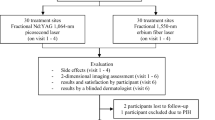Abstract
Post-surgical facial scars are often associated with unaesthetic outcome. Treatment of these scars using various lasers could be beneficial; however, the use of the Q-switched fractional (QSF) 1064-nm neodymium-doped yttrium aluminum garnet (Nd:YAG) laser has yet to be evaluated for this indication. Our objective was to determine the safety and efficacy of a QSF-Nd:YAG laser for the treatment of post-surgical facial scars. Eleven (5 male, 6 female) patients who underwent facial surgery with significant scarring were treated using the QSF-Nd:YAG laser. Scars were exposed to 600–1200 mJ/stacked pulses (12–24 mJ per pixel), emitted at a rate of 10 Hz for up to 2 passes per treatment session, receiving overall 3–6 treatments. Patient follow-up was 3 months. Scars’ photographs were blindly assessed by two dermatologists, who graded them on a scale of scar severity from 1 to 5 (1 = least severe, 5 = most severe) before and after treatment. A blinded before/after recognition of these photographs was also performed. Patient satisfaction was assessed 3 months post-treatment and graded on a scale of 1–5 (1 = not satisfied, 5 = very satisfied). Pain perception and adverse effects were also evaluated. Patients demonstrated a decrease in scar severity score by a mean of 1.57 points (p = 0.0005). A blinded before/after recognition was correct in 86.5% of the cases. Pain and adverse effects were mild and transient. Patient satisfaction was high (4.2). QSF-Nd:YAG laser is a safe and effective modality for the treatment of post-surgical facial scars.



Similar content being viewed by others
References
Young VL, Hutchison J (2009) Insights into patient and clinician concerns about scar appearance: semiquantitative structured surveys. Plast Reconstr Surg 124(1):256–265
Ward RE, Sklar LR, Eisen DB (2019) Surgical and noninvasive modalities for scar revision. Dermatol Clin 37(3):375–386. https://doi.org/10.1016/j.det.2019.03.007
Politi Y, Levi A, Lapidoth M (2016) Integrated cooling-vacuum- assisted non-fractional 1540 nm erbium:glass laser is effective in treating acne scars. J Drugs Dermatol 15(11):1359–1363
Politi Y, Levi A, Enk CD, Lapidoth M (2015) Integrated cooling-vacuum-assisted 1540-nm erbium:glass laser is effective in treating mild-to-moderate acne vulgaris. Lasers Med Sci 30(9):2389–2393
Tidwell WJ, Owen CE, Kulp-Shorten C, Maity A, McCall M, Brown TS (2016) Fractionated Er:YAG laser versus fully ablative Er:YAG laser for scar revision: results of a split scar, double blinded, prospective trial. Lasers Surg Med 48(9):837–843
Vas K, Gaál M, Varga E et al (2014) Effects of the combined PDL/Nd:YAG laser on surgical scars: vascularity and collagen changes evaluated by in vivo confocal microscopy. Biomed Res Int 2014:1–8
Ezra N, Dodgen T, Arshanapalli A, Somani A-K (2014) Successful use of the microsecond 1,064-nm Nd. Dermatologic Surg 40(12):1420–1422
Cho SB, Lee JH, Lee SH, Lee SJ, Bang D, Oh SH (2010) Efficacy and safety of 1064-nm Q-switched Nd:YAG laser with low fluence for keloids and hypertrophic scars. J Eur Acad Dermatol Venereol 24(9):1070–1074
Badawi A, Tome MA, Atteya A, Sami N, Morsy IAL (2011) Retrospective analysis of non-ablative scar treatment in dark skin types using the sub-millisecond Nd:YAG 1,064 nm laser. Lasers Surg Med 43(2):130–136
Sherman R, Rosenfeld H (1988) Experience with the Nd:YAG laser in the treatment of keloid scars. Ann Plast Surg 21(3):231–235
Akaishi S, Koike S, Dohi T, Kobe K, Hyakusoku H, Ogawa R (2012) Nd:YAG laser treatment of keloids and hypertrophic scars. Eplasty. 12:e1
Maluki AH, Mohammad FH (2012) Treatment of atrophic facial scars of acne vulgaris by Q-switched Nd:YAG (neodymium: yttrium-aluminum-garnet) laser 1064 nm wavelength. J Cosmet Laser Ther 14(5):224–233
Al-Dhalimi M, Jaber A (2015) Treatment of atrophic facial acne scars with fractional Er:Yag laser. J Cosmet Laser Ther 17(4):184–188
Sadick NS, Cardona A (2018) Laser treatment for facial acne scars: a review. J Cosmet Laser Ther 20(7–8):424–435
Acknowledgments
We are grateful to Dr. Igor Snast, MD and Prof. Daniel Mimouni, MD who graciously evaluated before and after photos of the patients taking part in this study.
Author information
Authors and Affiliations
Corresponding author
Ethics declarations
Conflict of interest
The authors declare that they have no conflict of interest.
Additional information
Publisher’s note
Springer Nature remains neutral with regard to jurisdictional claims in published maps and institutional affiliations.
Rights and permissions
About this article
Cite this article
Akerman, L., Solomon-Cohen, E., Rozenblat, M. et al. 1064-nm Q-switched fractional Nd:YAG laser is safe and effective for the treatment of post-surgical facial scars. Lasers Med Sci 36, 871–874 (2021). https://doi.org/10.1007/s10103-020-03134-8
Received:
Accepted:
Published:
Issue Date:
DOI: https://doi.org/10.1007/s10103-020-03134-8




